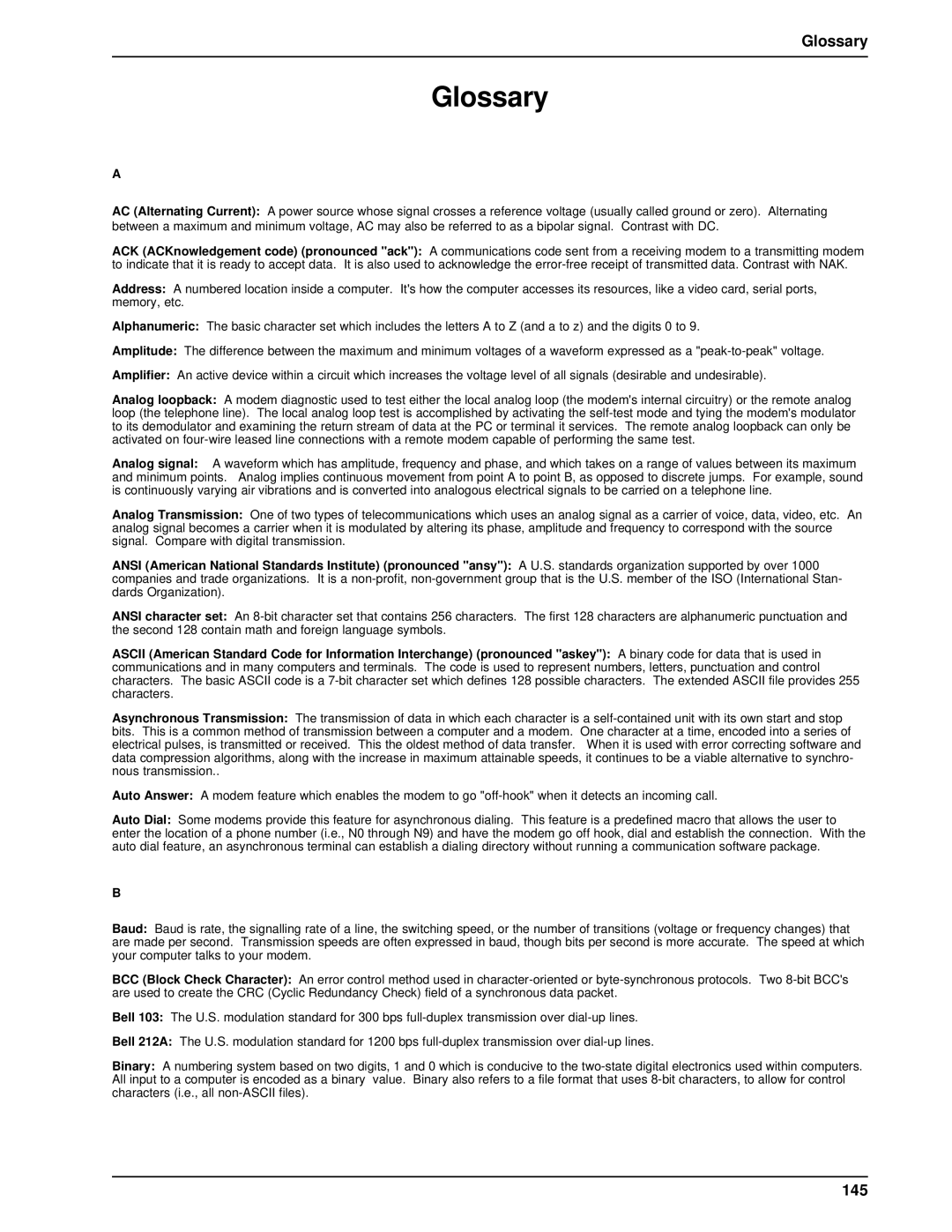
Glossary
Glossary
A
AC (Alternating Current): A power source whose signal crosses a reference voltage (usually called ground or zero). Alternating between a maximum and minimum voltage, AC may also be referred to as a bipolar signal. Contrast with DC.
ACK (ACKnowledgement code) (pronounced "ack"): A communications code sent from a receiving modem to a transmitting modem to indicate that it is ready to accept data. It is also used to acknowledge the
Address: A numbered location inside a computer. It's how the computer accesses its resources, like a video card, serial ports, memory, etc.
Alphanumeric: The basic character set which includes the letters A to Z (and a to z) and the digits 0 to 9.
Amplitude: The difference between the maximum and minimum voltages of a waveform expressed as a
Amplifier: An active device within a circuit which increases the voltage level of all signals (desirable and undesirable).
Analog loopback: A modem diagnostic used to test either the local analog loop (the modem's internal circuitry) or the remote analog loop (the telephone line). The local analog loop test is accomplished by activating the
Analog signal: A waveform which has amplitude, frequency and phase, and which takes on a range of values between its maximum and minimum points. Analog implies continuous movement from point A to point B, as opposed to discrete jumps. For example, sound is continuously varying air vibrations and is converted into analogous electrical signals to be carried on a telephone line.
Analog Transmission: One of two types of telecommunications which uses an analog signal as a carrier of voice, data, video, etc. An analog signal becomes a carrier when it is modulated by altering its phase, amplitude and frequency to correspond with the source signal. Compare with digital transmission.
ANSI (American National Standards Institute) (pronounced "ansy"): A U.S. standards organization supported by over 1000 companies and trade organizations. It is a
ANSI character set: An
ASCII (American Standard Code for Information Interchange) (pronounced "askey"): A binary code for data that is used in communications and in many computers and terminals. The code is used to represent numbers, letters, punctuation and control characters. The basic ASCII code is a
Asynchronous Transmission: The transmission of data in which each character is a
Auto Answer: A modem feature which enables the modem to go
Auto Dial: Some modems provide this feature for asynchronous dialing. This feature is a predefined macro that allows the user to enter the location of a phone number (i.e., N0 through N9) and have the modem go off hook, dial and establish the connection. With the auto dial feature, an asynchronous terminal can establish a dialing directory without running a communication software package.
B
Baud: Baud is rate, the signalling rate of a line, the switching speed, or the number of transitions (voltage or frequency changes) that are made per second. Transmission speeds are often expressed in baud, though bits per second is more accurate. The speed at which your computer talks to your modem.
BCC (Block Check Character): An error control method used in
Bell 103: The U.S. modulation standard for 300 bps
Bell 212A: The U.S. modulation standard for 1200 bps
Binary: A numbering system based on two digits, 1 and 0 which is conducive to the
